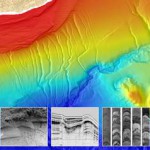The Christchurch earthquake was the main topic of the Geoblogosphere this week. A great analysis on the effects was provided by Dave Petley in his Landslide Blog. Highly Allochthonous reasoned on seismic lensing, Ontario Geofish posted a lot on building security, and countless news sites came up with photos and reports. Frank Taylor, who hosted the GoogleEarthBlog before he left for a sailing trip around the world, was in Christchurch next to the Cathedral when the quake happened. On his Tahina Expedition website he reports on his experiences.
-
What’s up? The Friday links (8)
2011-02-25 | in The Friday Links -
Why was the Christchurch earthquake so devastating?
2011-02-23 | in Teaching | 3 responsesA M6.3 earthquake hit Christchurch, New Zealand on 22 February (21 Feb in UTC), leaving at least 75 people dead and hundreds injured or missing. Hundreds of houses were destroyed, including the Christchurch Cathedral, and damages will probably sum up to some billion dollars. On 4 September 2010 (3 Sept in UTC), a M7.0 event struck Christchurch, but then no one was killed. So: what’s the difference between the two events?
-
What’s up? The Friday links (7)
2011-02-18 | in The Friday LinksAlbini made forensic studies on the origin of “fake” earthquakes in historical catalogues and shows in her new paper how the 1272 earthquake “happens”. I like the paper as it provides some insights in the structure of earthquake catalogues and their interactions. It shows how historical and paleoseismological studies may complement each other. -
Friday’s earthquake and Darwin gap
2011-02-15 | in PaperA nice short discussion about the Lorito et al., 2011 paper regarding the seismic gap at the Chilean coast and seismic slip during the 2010 earthquake, can be found at Highly Allochthonous. The discussion highlights the paper findings under the glance of the recent Bio-Bio earthquake from Friday, which took place in this so called Darwin gap.
-
Registration for Corinth2011 opened
2011-02-14 | in Corinth 2011The registration for the 2nd INQUA-IGCP 567 International Workshop on Active Tectonics, Earthquake Geology, Archaeology and Engineering at 19th-24th September 2011 in Corinth, Greece is opened.
-
What’s up? The Friday links (6)
2011-02-11 | in The Friday LinksToday on Friday, 11 February, a magnitude 7.0 earthquake occurred offshore in Chile near Concepcion at 36.5° S and 73° W in a depth of 28km. The MMI at the nearby large cities was reported by the USGS with V.
Update: The magnitude was corrected to 6.8. The earthquake was followed one hour later by a further event with a magnitude of 5.3 and 4 hours later again by a more shallow 6.3.
more -
Searching for Records of Past Earthquakes Under Water
2011-02-08 | in Paper In its latest issue, EOS reports on the European Science Foundation conference “Submarine Paleoseismology – The Offshore Search of Large Holocene Earthquakes” which was held in Obergurgl, Austria from 11-16 September 2010.
In its latest issue, EOS reports on the European Science Foundation conference “Submarine Paleoseismology – The Offshore Search of Large Holocene Earthquakes” which was held in Obergurgl, Austria from 11-16 September 2010. -
What’s up? The Friday links (5).
2011-02-04 | in The Friday Links The Accredtionary Wedge #30 blog carnival hosted by Mountain Beltway came up with a tasting idea in January: The Geological Bake Sale. Explore and enjoy thematic food like the moon surface cake, the pillow lava bread and the debris flow vegetables. If you create a sweet fault or a tasty trench, we promise to publish it on paleoseismicity.org. more
The Accredtionary Wedge #30 blog carnival hosted by Mountain Beltway came up with a tasting idea in January: The Geological Bake Sale. Explore and enjoy thematic food like the moon surface cake, the pillow lava bread and the debris flow vegetables. If you create a sweet fault or a tasty trench, we promise to publish it on paleoseismicity.org. more -
Oxford University Press Book Sale
2011-02-01 | in Uncategorized Oxford University Press is currently selling selected books with up to 75% off. The promotion covers dozens of books, among them titles on Archeology, GIS and Geography.
Oxford University Press is currently selling selected books with up to 75% off. The promotion covers dozens of books, among them titles on Archeology, GIS and Geography.Most titles are related to human sciences, but there might be something interesting for paleoseismologists and earthquake geologists, too. more
-
What’s up? The Friday links (4)
2011-01-28 | in The Friday Links The California Geological Survey provides a great online-tool for geoscientist: A fault map of California (Alquist-Priolo-Fault-Zone with all datasets available in PDF and GIS format for free! Start here.
The California Geological Survey provides a great online-tool for geoscientist: A fault map of California (Alquist-Priolo-Fault-Zone with all datasets available in PDF and GIS format for free! Start here.A volunteer panel that assesses earthquake risks in Utah said it examined nearly 130 school buildings in the state and found more than half fail to meet federal earthquake safety guidelines. Bad news from here.
